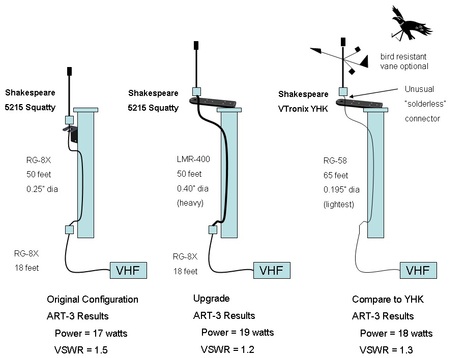Shakespeare VTronix YHK Sailboat Antenna

It's easy to surmise from the appearance of a wind indicator on top, that the Shakespeare YHK antenna was optimized for sailboats. Beyond the wind indicator (which is optional), this antenna features (i) an all round lightweight design, (ii) low windage, (iii) a flat masthead mounting bracket, and (iv) an unusual connector fitting at the antenna end of the coax cable, all of which are ideal features for a sailboat. While saving weight on a sailboat is always a good thing, the lightweight design of the antenna and cable reduces weight in the most critical area of a sailboat, the mast, where any extra weight aloft comes with a strong performance penalty. Plus, the flat mounting bracket is useful for positioning the antenna above the masthead, something that isn't possible with a side antenna mount. With a side mount, anywhere from 5% to 15% of the length of a standard 36" high sailboat antenna is blocked by the mast for almost half the radius, reducing the ability of the antenna to perform well when transmitting or receiving in that direction...
The unusual connector is really special. Unlike a typical fat PL-259, this connector and the included 65 foot lightweight cable is quite easy to snake through a sailboat mast. The other end (which you don't need to snake) is the standard PL-259 connector that attaches to the back of the VHF radio. The ability to easily add or remove this coax seasonally from the mast provides the owner an option to do away with a mid-length deck level connector at the base of the mast. Such connectors usually consist of a female-female adapter and two PL-259 connectors, which is a source of signal loss from the start, and a risk for further signal loss should the outside surface on the connector corrode.
The YHK antenna was tested at a height of 10 feet above the water, with no people or metallic obstructions within 20 feet of the antenna. A Shakespeare ART-3 tester, inserted at the output of an ICOM-M422 25 watt VHF radio, was used to measure losses of the entire antenna system. The ART-3 measured 18 watts of power (larger numbers are better) and a VSWR of 1.3 (smaller numbers are better, 1.0 is optimal).
The ART-3 -- which was once tested here on Panbo -- was also used to measure the losses of the author's antenna system on a 39 foot Beneteau sailboat. The antenna system does have a connector mid-length in the RG-8X coax, at the base of the mast, allowing the coax to be disconnected whenever the mast is removed. The ART-3 measured the factory configuration for the sailboat, using a total of 68 feet of RG-58X with a Shakespeare 5215 Squatty antenna, 17 watts of power and a VSWR of 1.5. Not as good as the YHK, despite the larger and better width coax cable. Clearly the smaller cable and unique solder-free connector is a winning combination.
The ART-3 was also used to measure the losses of the author's improved antenna system, with an upgraded coax segment from the base to the masthead made of LMR-400 coax cable. This type of cable has much better performance than RG-8X cable, but is extremely difficult to bend or snake through a mast. The ART-3 measured 19 watts of power and a VSWR of 1.2. This is marginally better than the YHK antenna and cable combination, but with a huge weight penalty. (LMR-400 is easily 3 times the weight of the YHK antenna per foot, and has other disadvantages as well)
Clearly, the Shakespeare YHK antenna succeeds in its design goal of creating an antenna system optimized for sailboats, and the wicked light coax cable is not a problem as long as the installer can avoid cutting the coax at the deck. As a bonus, owners can benefit from having a wind indicator with a built in bird deterrent (the metal antenna whip) which prevent birds from landing and causing damage.
- Dan Corcoran is an avid sailor and leads ServiceSPAN a back office work center automation technology company.


 Share
Share
It's nice to have only one mount point for both the antenna and Windex. Also, the mounting bracket is plastic, so there is no need to DC isolate the antenna from the mast. I have used one for a year with no problems so far. But don't leave the Windex on it's side facing the sun in the back seat of your car or it will warp!
Cheers,
Noel